Whether you know about them or not, there are many different types of peppers.
Peppers come in all shapes, sizes, and colors. There are sweet peppers, and there are spicy peppers.
There are bell peppers, and there are jalapeno peppers.

Then there are all the other types of peppers you might not have heard of before.
Don’t worry, though. I’m here to introduce you to them!
I’ll tell you about the different types of peppers and list their Scoville Heat Unit scores and what they look like. Keep reading!
25 Types of Peppers and Their Heat Scale
Everybody knows what peppers are, even if they don’t know all the different types.
However, not everyone knows about the Scoville scale.
The Scoville scale is “a measurement of the pungency of chili peppers.”
Milder peppers rank lower on the scale, while hotter ones rank higher.
Each pepper is awarded a number of Scoville Heat Units or SHUs.
For the 25 peppers below, I’ve included their Scoville score beside their names.
1. Bell Peppers: SHU: 0
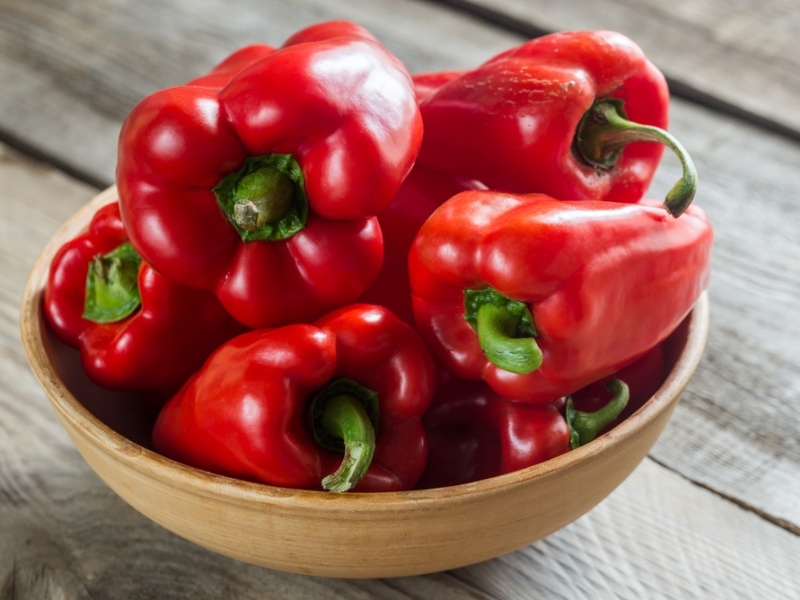
Whether red, orange, or green, bell peppers are some of the mildest.
In fact, they rank a big, fat ZERO on the Scoville scale because they’re sweet peppers.
They’re also some of America’s most widely grown and consumed peppers.
They come in multiple colors and taste great raw or cooked in recipes.
They’re a popular option for stir-fries, salads, and for making paprika.
2. Banana Peppers: SHU: 0 to 500
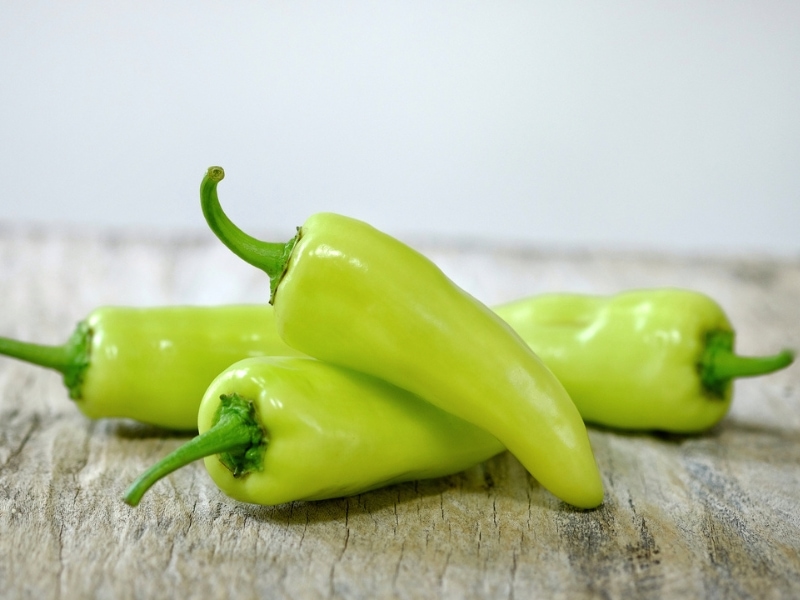
With a SHU of zero to 500, banana peppers are slightly spicy.
(They’re still considered sweet peppers, though.) Unlike bell peppers, they also have a zingy, tangy taste.
They often come pickled in brine, giving them a waxy texture and a juicy bite.
You can add them to salads, sandwiches, pizza, and other recipes. Mostly, people eat them raw or pickled.
3. Shishito Peppers: SHU: 100 to 1,000
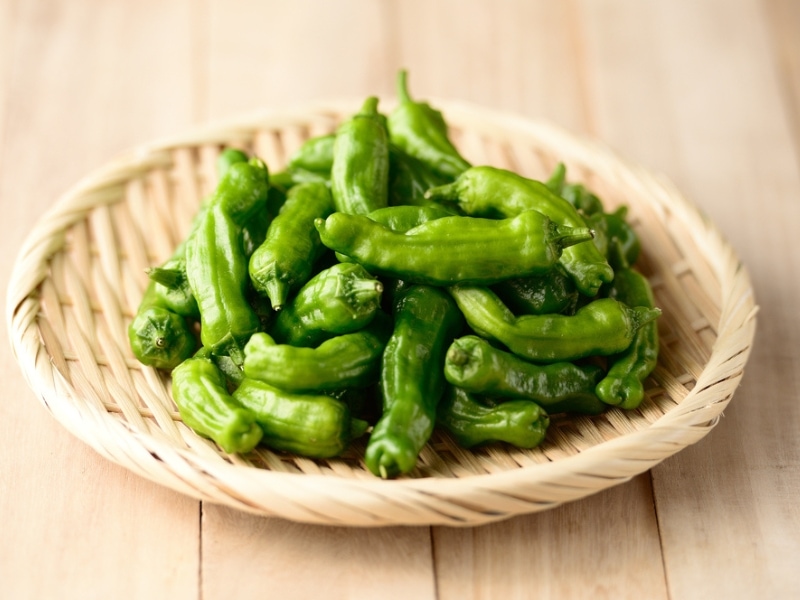
The Scoville range for shishito peppers goes from 100 to 1000. That seems like a pretty big leap, right? That’s because it is.
Most shishito peppers are pretty mild. However, now and then, you’ll bite into one that has a real bite!
Eating them is like playing Russian roulette with peppers.
You can eat them raw, but mostly, you’ll find them charred, grilled, or blistered. (Particularly in Asian or Japanese restaurants.)
4. Sweet Italian Peppers: SHU: 100 to 500
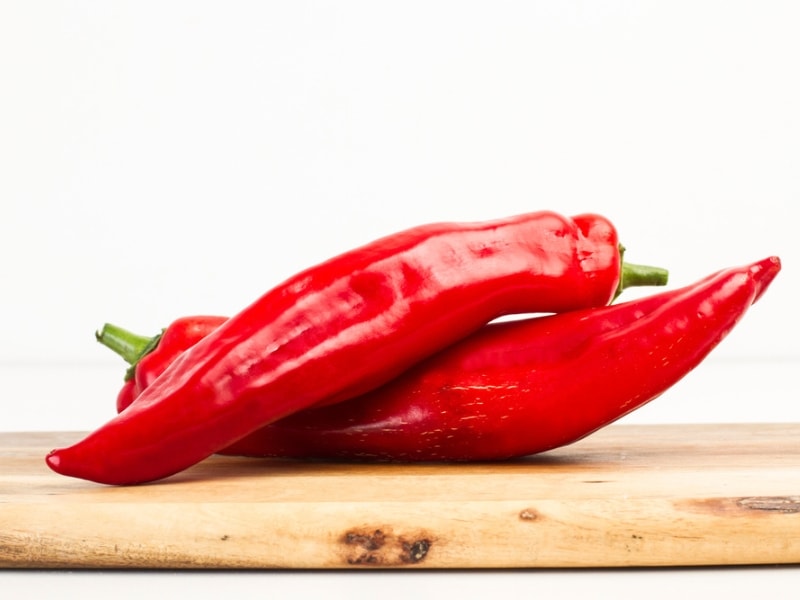
Sweet Italian peppers have several names.
Some people call them pepperoncini, while others refer to them as friggitello peppers.
Whatever you call them, they’re the same mild pepper with a tangy flavor.
They look and taste almost precisely like banana peppers. You can use them in the same ways.
5. Pimento Pepper: SHU: 100 to 500

Have you ever had a pimento cheese sandwich? If so, you’ve likely had pimento peppers, even if you didn’t know.
They’re also called cherry bell peppers and are medium-sized, red, and not too hot.
As their name implies, they’re great for chopping up and adding to pimento cheese.
However, they’re also excellent peppers for stuffing.
6. Hatch Peppers: SHU: 0 to 100,000

Remember earlier when we thought 100 to 1,000 was a big jump?
Check out the Scoville scale for hatch peppers: zero to 100,000! That’s insane, right?!
Also known as New Mexico chiles, they have an earthy, robust flavor. There’s also a touch of smokiness in their taste.
They’re about 8 to 13 inches long and light greenish.
Most range between 1,500 and 3,500 SHUs, but occasionally, you can get an ultra-hot one.
7. Poblano Peppers: SHU: 1,000 to 5,000

Poblano peppers are popular ingredients in Mexican cuisine.
They’re large, bright green peppers that start out mild and get hotter as they ripen.
People often dry and powder them to make ancho chile powder. They’re also a popular ingredient in mole sauces.
8. Jalapeño Peppers: SHU: 3,500 to 8,000

Jalapenos are some of the best-known of all hot peppers.
Like banana peppers, they typically come pickled in brine. However, you can also buy them raw.
Most people think of them as green, but they turn red when ripe.
They’re relatively small peppers with a sweet, bell pepper-like flavor. (Only with a lot more heat.)
Typically, people don’t eat jalapenos raw. Instead, they add them to sandwiches, soups, salads, and more.
Despite how hot people think they are, they’re on the low end of the spicy pepper scale.
You can also remove much of the bite by deseeding them.
9. Serrano Peppers: SHU: 10,000 to 23,000

Serrano peppers are small green peppers that turn redder as they ripen.
They have a fresh, earthy flavor similar to jalapenos but are hotter.
Like poblanos, they’re regularly found in Mexican and Latin American cuisine.
They’re also a popular ingredient in salsa and mole sauces.
10. Cayenne Peppers: SHU: 30,000 to 50,000

Powdered cayenne pepper is one of my favorite seasonings.
However, as little as a fourth of a teaspoon too much can ruin your dish. It’s that hot.
You can occasionally find these orange or red peppers raw and whole.
Most of the time, the powdered form is all you’ll get.
11. Habanero Peppers: SHU: 100,000 to 576,000

Though habaneros come in many colors, red and orange are the most prevalent.
The orange ones are sweeter and not as hot (100k – 200k SHUs). Though, they’ll still set your mouth on fire.
The red ones can range up to 576,000 SHUs.
They’re a popular ingredient in fruit-based salsas because of their sweetness.
Thanks to their heat, most people never notice that sweetness, though.
12. Ghost Peppers: SHU: 1,000,000

For the longest time, ghost peppers were considered the hottest of the hot, and for good reason!
These Indian-native peppers are extremely hot. They’re over 100 times hotter than jalapenos.
People occasionally take a bite of raw ghost pepper on a dare or for internet fame.
Unfortunately, they’re far too hot to eat raw for any other reason.
They make great additions to chutneys, nachos, hot sauces, etc.
13. Carolina Reaper: SHU: 1,000,000 to 2,000,000

Notice how I said ghost peppers were considered the hottest of the hot? That’s because Carolina reapers dethroned them in 2017.
They’re small, wrinkly peppers with a Scoville score that’ll set your whole body on fire.
Take a bite of these bad boys at your own risk.
14. Tabasco Pepper: SHU: 30,000 to 60,000

In all my years on this earth, I’ve never seen a Tabasco pepper in the flesh.
I know Tabasco peppers the same way most people do, from Tabasco sauce.
The peppers are small (about two inches long) and bright red. They’re hot and actually juicy on the inside, unlike most peppers.
The raw peppers are much hotter than the sauce of the same name.
15. Anaheim Peppers: SHU: 500 to 2,000

Though Anaheim peppers have a bit of spice, they aren’t all that hot.
They range in size from 6 to 10 inches and are dark green to red.
They’re some of the most famous and widely consumed of all the chile varieties.
You can purchase them raw, dried, or canned in most grocery stores.
16. Basque Fryer: SHU: 0

Also known as French peppers, basque fryers are long, skinny, and green.
They often grow in odd, twisting shapes and have no heat.
You can eat them raw, but they’re primarily used in French cuisine.
They have a distinctive peppery taste with hints of fruity sweetness.
17. Piri Piri: SHU: 50,000 to 175,000

Piri piri peppers have an adorable name to match their adorable appearance. They almost look like small cherry tomatoes.
Don’t let their cuteness fool you. These little guys are hot, hot, hot. They aren’t very popular in America.
But you’ll find them often in African and Portuguese cuisine.
They’re also the base for various hot sauces, specifically in Africa.
18. Rocoto: SHU: 30,000 to 100,000

Though not as well-known as habaneros and poblanos, rocotos often appear in salsa.
They have a similar Scoville score to habaneros and look like bell peppers.
They come in a wide range of colors and are relatively large.
They also have dark black seeds that set them apart from other pepper varieties.
19. Guajillo: SHU: 2500 to 30,000

Most guajillos are about as hot as jalapenos, though some can get much hotter.
In their raw form, they’re smooth, red, and between three and five inches long.
Typically, they come in dried form. People often use them in salsa, mole sauces, and Mexican cuisine.
20. Scotch Bonnet: SHU: 100,000 to 350,000

To have such a sweet, non-threatening name, Scotch bonnet peppers are hot.
People overlook them because they don’t have a name like ghost pepper or Carolina reaper.
Still, they’ll just as quickly set you on fire.
They take their name from their scrunched appearance and come in various colors.
21. Bird’s Eye Chili Pepper: SHU: 50,000 to 100,000

Do you enjoy Thai cuisine? If so, you’ve probably had bird’s eye chili peppers, which are popular in Thailand.
They’re hotter than cayenne peppers but not quite as hot as habaneros.
They’re short, orangey-red, and relatively thin.
22. Cubanelle Peppers: SHU: 500 to 1,000
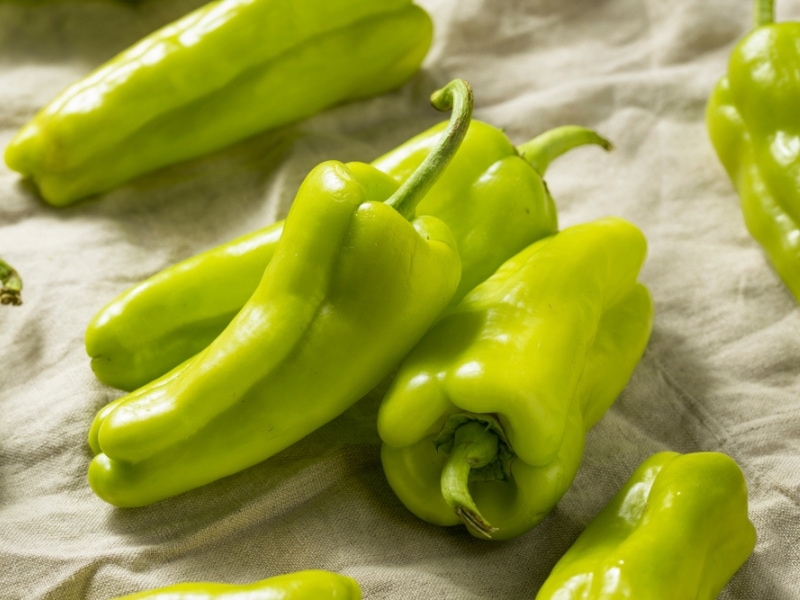
Cubanelle, or Cuban peppers, are slightly hotter than bell peppers.
However, they’re still considered sweet peppers and don’t have much bite.
They’re great for use in fajitas and stir-fries, but you can substitute them for bell peppers in practically any recipe.
23. Piquillo Peppers: SHU: 500 to 1,000

The name piquillo translates to “little beak.” It describes these small red peppers’ shape perfectly.
They’re mild and sweet and taste great when roasted.
It’s rare to find them raw, though they sometimes pop up in specialty stores.
More often, you can buy them canned and preserved in oil.
24. Fresno Chili Pepper: SHU: 2,500 to 10,000

If you want to fire roast peppers, find Fresno peppers. They taste unbelievably good when fire roasted.
You can also eat them raw, but they’re pretty spicy. (Hotter than jalapenos.)
If you can get past the heat, they have a wonderful sweetness.
They’re great for adding to soups, stews, and sauces.
25. Aji Charapita Hot Pepper: SHU: 30,000 to 100,000
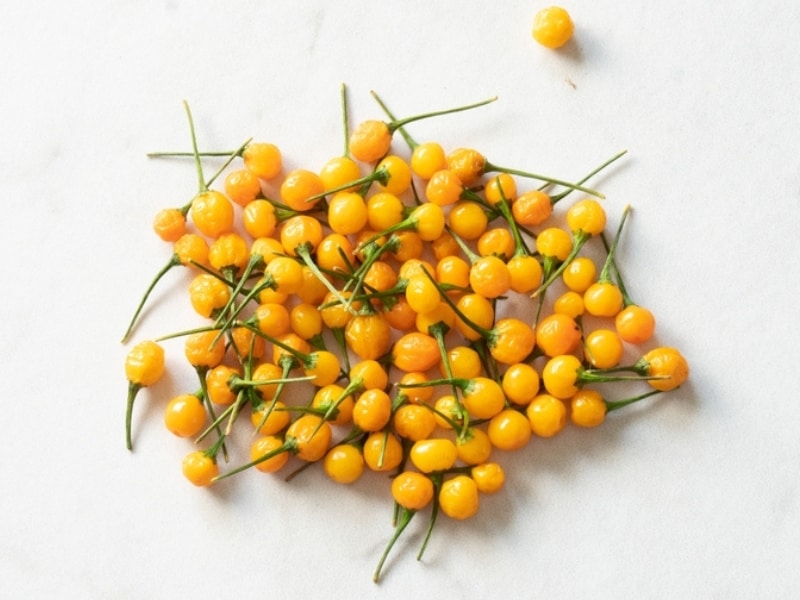
Despite being only the size of a pea, these peppers are the most expensive in the world.
They grow in Northern Peru and are bright yellow and perfectly round.
Peruvian chefs love adding them to their dishes, perhaps for sheer decadence’s sake.
Outside of Peru, though, they’re almost impossible to find.












Hey there, I am about to run a restaurant that why I surf this page especially to know the different types of peppers… You guys are so helpful… Thank you very much.